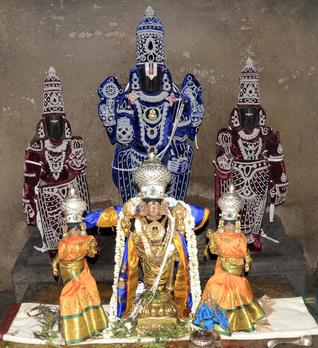Sri Abeeshta Varada Perumal adorned with Muthangi. / Photo: B. Velankanni Raj / The Hindu
Karappankadu near Madukkur in Pattukottai taluk, Thanjavur district, has a famous Vaishnavite temple called Abeeshta Varada Perumal temple or Devaperumal temple. Karappankadu is one among the Panchagramams in Thanjavur district. Other places are Nammankurichi, Puliyankudi, Serankulam and Peravurani.
How the temple came into existence at Karappankadu is an interesting story. Legend has it that a group of Vaishnavite scholars, that travelled from Kanchipuram to Thirupullani, in Ramanathapuram district, had to stay in a forest near Pattukottai for a night. The chieftain of the area, Karuppan Devan, was attracted by the devotion of the scholars towards the Lord of Kanchi – Varadaraja Perumal – and asked them to stay in that place itself.
The scholars stayed in the place and named it after the chieftain i.e., Karuppankadu which later became Karappankadu. The scholars, however, longed to see Varadaraja Perumal of Kanchipuram. It is said that Perumal appeared in their dream and asked them to take His idol, which was lying buried at Moorthiyambalpuram near Vaduvur, and that the place can be identified with the Garuda flying over the sky. After having found the idols of the Lord and His consorts, the scholars built a temple and installed the idols. As the Lord fulfilled the wishes of the scholars, He is called ‘Abeeshta Varadan’ (one who fulfils the wishes of His devotees).
Karappankadu is also the birth place of Vaishnavite saints such as Singaperumal Swamy, Desika Varadachar Swamy, who later became Sri Rangam Jeer and Venkatachar Swamy.
On December 22, this year, a devotee of the temple, V. Thiruvenkatasamy, son of Varadachariyar, has offered Muthangi to moolavar Deva Perumal, Pakkathu Nachiyars and moolavar Perundevi. He also offered stone-studded crowns to Moolavar Abeeshta Varadan and His consorts. Hundreds of people witnessed the event and worshipped the Lord and Goddess.
source: http://www.TheHindul.com / Home> Arts> History & Culture> by G. Srinivasan / December 27th, 2012
